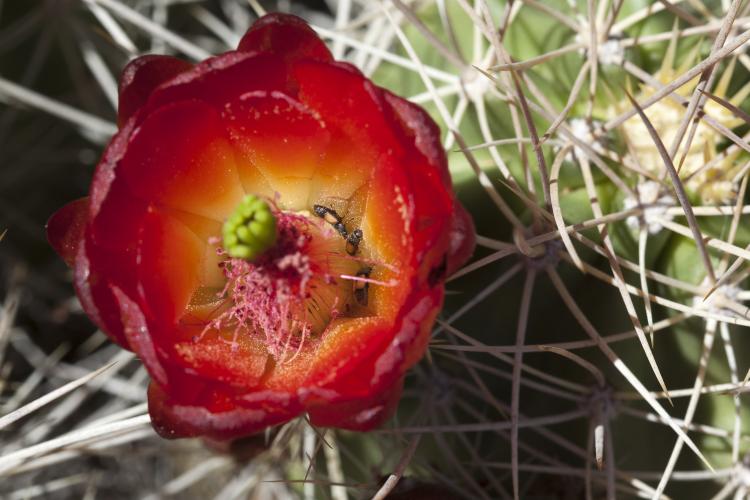The beetles in the cactus flowers are not pollinators
Last May I went to Knowles Canyon Overlook Campground to enjoy magnificent scenery. Quite unexpectedly, I stumbled across small beetles in cactus blooms and an unexpected ecological interaction.
As you travel west on Interstate 70 through Colorado, you enter McInnis Canyons National Conservation Area between Colorado National Monument and the Utah border. It is most well known for the Black Canyons Wilderness and Rattlesnake Canyon south of the Colorado River, but on this trip my destination was Rabbit Valley, which is bounded on the north by I-70, on the south by the Colorado River, and on the west by the Utah/Colorado state boundary. I stayed for several days on the campground on the rim of the Canyon of the Colorado, several hundred feet above the water, and a sweeping view of the Colorado River Canyon and fine views of McDonald Canyon and Knowles Canyons.
Three cactus beetles in this claret cup cactus bloom are there to eat and lay eggs, but do not pollinate the flower. Click here or on photo to see larger image. Photo by Jeff Mitton.
The scenery was superb. Occasionally, the California Zephyr would rumble through the canyon on a narrow strip of flat land between the water and the base of the canyon's northern wall.
A large portion of Rabbit Valley is a near monoculture of cheatgrass, an invading species that covered in my column posted Oct. 21, 2016. The sight of all the cheatgrass is disheartening, but a more natural environment, including desert crust and many native wildflowers,persists along the rim of McDonald Canyon. Desert four o'clock (column Sept. 23, 2016), cushion buckwheat, penstemon and Indian paintbrush were in bloom.
The cacti were flowering and their blooms were abundant. I think I found several species of prickly pear, bearing flowers with yellow, red and cream or caramel blooms. Claret cup cactus had some blooms open and others yet to open, and some were large, with over 60 blooms or buds on a single plant. My favorite, perhaps because it is least common, was Whipple's fishhook barrel cactus, with lovely magenta petals. I spent some time photographing cactus flowers until the beetles caught my attention.
I was focusing on a claret cup when I noticed several beetles near the base of the stamens (a stamen is an anther and its supporting filament). They were small, slightly over ¼ inch long, each with dark head, thorax and abdomen, but yellow elytra or wing covers. They were moderately active inside the flower, but they did not venture onto the pistil, nor did I see any moving between flowers--they seemed content to stay deep in the flower.
To test whether beetles in cactus flowers was a single curious observation or a common occurrence, I searched other cactus flowers and found them in every prickly pear, claret cup and fishhook cactus bloom that examined that day and the next. I presumed that they were pollinators, but I was not thinking critically.
Verne Grant, an authority on pollination biology, evolution and plant speciation, wrote several papers on these beetles in 1979. He noted that they usually arrived by landing on a petal, walking to the base of the stamens without touching the pistil. His observations on prickly pear flowers revealed that the beetles ate pollen and nibbled on stamens and petals, but did not pollinate flowers. Beetles arrived when the flower opened and promptly laid eggs at the base of the stamens. Eggs hatched in 3 to 5 days, larvae fed on flower parts for several days and then left the flowers to bury into the soil and pupate. They emerge as adults about two weeks later and return to flowers to eat. After describing the life cycle, Professor Grant stated that the beetles were not pollinators but pollen thieves, a harsh condemnation from a pollination biologist.
Carpophilus pallipennis lacks a common name, but I refer to them as cactus beetles. They are common in western states, while a closely related species, C. floralis, is common from eastern states to Central America.
In one of Verne Grant's papers he said that initially he had assumed that the cactus beetles were pollinators. I made the same mistake, and while I was wrong, I was in good company.


